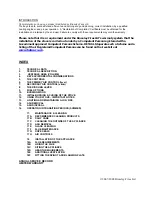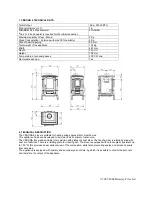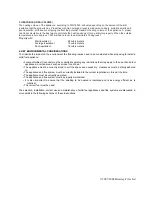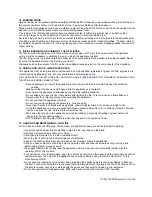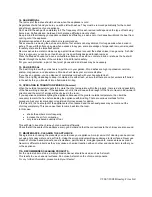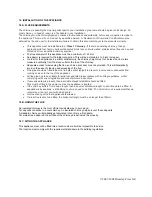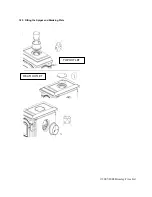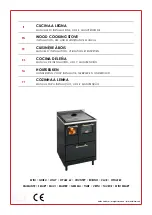
© 2007-2008 Broseley Fires Ltd
10. BURNING WOOD
Hardwoods have a far greater calorific value than softwoods. Most firewood you purchase will be green and have a
fair amount of water content. It will need to be stored in a well ventilated shelter to season it.
Wood used in this appliance must have a moisture content of less than 20%. Damp or wet wood will quickly form tar
deposits on all the internal areas where the combustible gasses travel.
.The inside of the chimney/flue will also become coated with tar, resulting in a greater risk of a chimney fires
occurring. Always use good quality wood, store it under cover in a well ventilated area.
Avoid burning oak bark, as this forms tar at a very fast rate.When selecting wood, also take into consideration ease
of splitting, ease of ignition and burning, how much smoke it produces and its "coaling" qualities. "Coaling" refers to
the ability of a species of wood to form a long- lasting bed of hot coals when burned. Coaling qualities improve with
higher density.
11. INITIAL BURNING AND CURING OF THE APPLIANCE
The first time that the appliance is lit, there will be an odour given off. This is the components of the appliance
curing. It will be necessary to ventilate the room in which the appliance is sited.
The first firing needs to be done carefully to allow all of the components of the appliance to settle gradually. Never
try to run the appliance flat out the first time you light it.
Gradually build up the output of the fire so that no sudden stresses are put on the components of the appliance.
12. USING YOUR STOVE - IMPORTANT NOTES
:
This appliance must be installed and commissioned by a fully qualified, registered engineer. HETAS engineers are
recommended by Broseley Fires. For your nearest search
www.hetas.co.uk
THE SURFACES OF THIS APPLIANCE GET HOT WHEN IN USE. PLEASE ENSURE THAT CHILDREN, THE ELDERLY AND
THE INFIRM ARE MADE AWARE OF THIS.
• Serious damage can result if the appliance is left running with the air controls fully open for extended
periods.
• Make sure that the door is not left open while the appliance is in operation.
• Never leave the appliance unattended during the initial lighting sequence.
• Do not attempt to open the door immediately after igniting the fire. This could cause a flame flash out.
• Always wear the protective gloves when operating the appliance.
• Do not overload the appliance with fuel.
• Do not burn wood containing chemicals (e.g. glue and paint).
• Never use chemicals or fluids such as gasoline, charcoal lighter, drain oil or kerosene to light a fire.
• Using the appliance on a very low output will cause excessive amounts of tar to build up inside the flue and
can be a serious fire risk, as this will fuel a chimney fire.
• We advise that you have the appliance serviced annually by a competent heating engineer before the
beginning of a new heating season.
• Don’t attempt to light the fire if there is a risk that any part of the system is frozen.
13. LIGHTING AND MAINTAINING A LOG FIRE
All chimneys and flues act differently. After a while, you will find out how your unit works best for starting.
• Use scrunched up paper and dry kindling to start the fire. Lay these on the grate.
• Open the primary and secondary air controls.
• It will take a few minutes for the fire to establish itself.
• When the fire is burning hot, add small pieces of hardwood.
• Keep all the draft controls fully open till a bed of hot, glowing embers is established.
• Once you have some red hot burning embers, open the door and rake the embers evenly over the grate
before adding larger pieces of wood.
• We suggest that you do not fully load the appliance until you have become completely familiar with the
operation of ALL the controls.
• For best results, in an ideal situation, open the primary air control one third open and the secondary air control
completely open. The output of the appliance can now be controlled using the thermostat control. This is
when burning LOGS.
• Do not open the loading door too quickly when reloading the appliance as this can cause flames to flash out
the door. This occurs when there is unburned fuel and a large amount of gases in the top of the firebox. When
the door is opened, oxygen is combined with the gases and these ignite, causing a ‘mini explosion’.
• Do not burn painted or varnished woods, MDF, oak bark or wood with more than 20% humidity.


